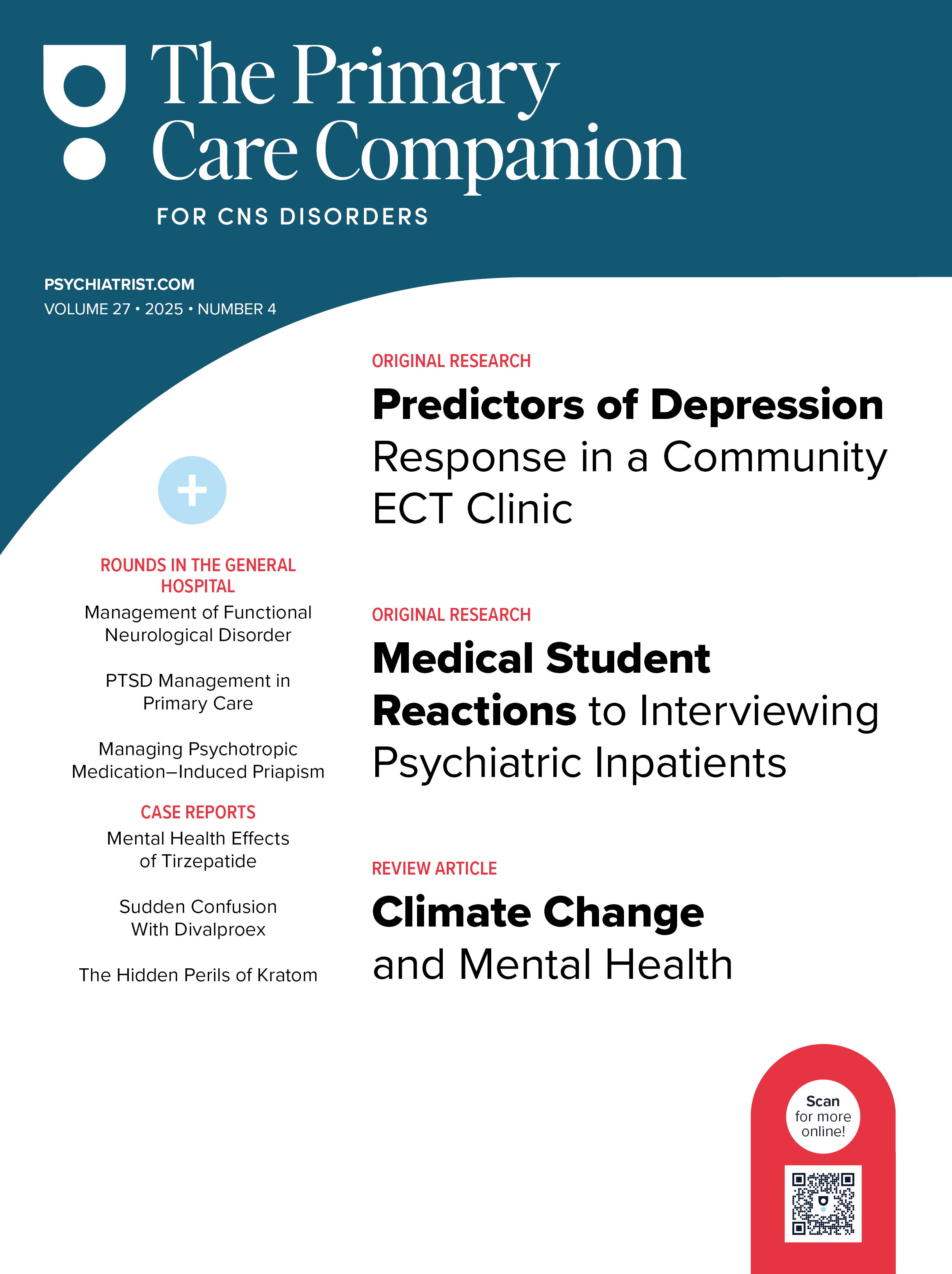Because this piece does not have an abstract, we have provided for your benefit the first 3 sentences of the full text.
These are exciting times both in psychiatric research and at the interface of psychiatry and primary care. Psychiatric research over the past decade has been invigorated by major developments in experimental techniques, ranging from advances in understanding genetic and epigenetic effects on behavior to advances in functional magnetic resonance imaging and positron emission tomography scans and novel probes of brain activity. In primary care, a major drive is underway to develop strategies to integrate psychiatric expertise through development of medical home practices.

Moving Forward
These are exciting times both in psychiatric research and at the interface of psychiatry and primary care. Psychiatric research over the past decade has been invigorated by major developments in experimental techniques, ranging from advances in understanding genetic and epigenetic effects on behavior to advances in functional magnetic resonance imaging and positron emission tomography scans and novel probes of brain activity. In primary care, a major drive is underway to develop strategies to integrate psychiatric expertise through development of medical home practices. While the majority of these initiatives involve integration of psychiatric expertise into the primary care setting, the inverse, adding primary care skills into psychiatric practice, is also underway.
While not as evident to those in primary care settings, several additional profound changes are occurring. One is the addition of a dimensional perspective regarding psychopathology as an alternative, and complement, to the symptom-based approach embodied in the DSM. This dimensional approach is the Research Domain Criteria (RDoC) project, which implements Strategy 1.4 of the 2008 National Institute of Mental Health (NIMH) Strategic Plan: "Develop, for research purposes, new ways of classifying mental disorders based on behavioral dimensions and neurobiological measures." As described on the NIMH website, "The heart of RDoC is a matrix of functional dimensions, grouped into broad domains such as cognition and reward-related systems, examined across units of analysis ranging from genetics and circuit activity to psychology and behavior. Emphasis is placed upon the developmental trajectories through which these functions evolve over time, and the interaction of neurodevelopment with the environment" (see http://www.nimh.nih.gov/research-priorities/rdoc/index.shtml to keep updated on the RDoC project). A practical extension of this approach called the Neuroscience-based Nomenclature, or NbN, is being adopted in Europe. This somewhat cumbersome name hides the fact that it is a patient-friendly strategy that will facilitate conversations with patients and families about treatment options. Using the NbN, depressed patients no longer will be offered "antipsychotics" and patients with attention-deficit/hyperactivity disorder no longer will be offered "stimulants." This approach will build a multiaxial system for describing medicines based on their mechanisms of action and pharmacology. It is a strategy that "can accommodate mechanistic understanding at any number of levels from molecules, to systems, to cognition." Endorsed by the European College of Neuropsychopharmacology, American College of Neuropsychopharmacology, International College of Neuropsychopharmacology, Asian College of Neuropsychopharmacology, and International Union of Basic and Clinical Pharmacology, the NbN is available both as a booklet and as an app (see http://www.ecnp.eu/projects-initiatives/nomenclature.aspx).
From a clinical perspective, perhaps an equally profound shift that is evolving relates to the goals of treatment. This shift broadens the focus from patient symptoms to include function and, ultimately, quality of life. In a subtle manner, this shift builds from the addition of a dimensional perspective to one that is symptom based. For decades, driven by the symptom-based conceptualization of treatment priorities inherent in the DSM, a reduction of symptoms and then remission of symptoms were the practical clinical goals. These goals have been reflected in the measures used to gauge treatment adequacy. For instance, we have focused professional attention on the first 9 questions of the Patient Health Questionnaire, rather than the 10th question, the one our patients and their families are most concerned about. (In case you are wondering, the 10th question is, "If you checked off any problems, how difficult have these problems made it for you to do your work, take care of things at home, or get along with other people?") Our focus shifts from remission to function, with the ultimate goal of functional recovery: "Are you back to work?" "Are you working (and relating to others and enjoying life) as you did before the onset of this illness?"
With this transition come new perspectives on the brain functions that are of priority interest. We have moved beyond the basal ganglia interest in gastrointestinal distress, fatigue, and insomnia to include the higher levels of cognitive function: "Can you think, concentrate, and view your social environment in a positive manner?" This is where these research themes intersect. For instance, research using fMRI and related imaging techniques have identified a number of key brain networks, including the central executive network, the salience network, and the default mode network that work together to manage cognitive processes. They interact with the central autonomic network (one of the "mind-body" connections) to influence somatic states and possibly chronic medical conditions as well cognition. This network perspective complements the amine neurotransmitter hypothesis of psychiatric disease. Abnormalities in brain networks, and their behavioral impact on functioning, involve a continuum (a focus of the RDoC approach) of severity across distinct DSM entities such as psychosis, bipolar disorder, and major depression. Similarly, medications and psychotherapies can alter both this brain circuitry and behaviors resulting in improved functioning.
Much is yet to be done. Translating these research insights into diagnostic and therapeutic strategies effective in helping our patients is a next step. Making these advances available broadly, including through multidisciplinary primary care teams, is a related step. Developing the tools for the routine measurement of function and cognition in practice to guide selection of the right medications, psychotherapies, and other therapies (eg, TMS) will be another. Work on these strategies is ongoing and likely to be of great benefit.
The Primary Care Companion for CNS Disorders will continue to bring you insights into these developments as they evolve, with a practical emphasis on content that can improve practice. Our publisher has taken the spirit of these advances to heart, with a greatly improved and easy-to-use interface for the Companion. Please let us know how it works for you—we seek to make the Companion a resource that fits easily into your busy professional life.
The Companion’ s ability to report on advances in science and practice pertaining to psychiatric and CNS diseases at their interface with primary care is greatly strengthened by the international base of manuscripts we receive. It builds on an assumption that there is no single expression of "truth" that can inform practice. The Companion therefore includes a variety of material, from case reports to descriptions of novel strategies to improve practice, to high quality clinical research including translational and implementation research. Please consider reporting your insights as you engage in your professional activities.
We benefit greatly from an outstanding group of peer reviewers, who not only help us select manuscripts but also guide revisions through their expertise to produce high-quality material to inform practice. We all benefit from the often unrecognized hours of work they contribute.
Prim Care Companion CNS Disord 2015;17(1):doi:10.4088/PCC.15ed01800
© Copyright 2015 Physicians Postgraduate Press, Inc.
Reviewers for The Primary Care Companion for CNS Disorders January 1, 2014-December 31, 2014
Scott T. Aaronson, MD
Yakup Albayrak, MD
Donna Ames, MD
Andrew J. Amos, MBBS
Drew A. Anderson, PhD
AnGee Baldini, MD
Robert L. Barkin, PharmD
Rachel D. Barnes, PhD
Carol A. Bernstein, MD
Murat Beyazy×¼z, MD
Rahul S. Bharadwaj, MD
Kenneth Blum, PhD
E. Sherwood Brown, MD
Thomas M. Brown, MD
Lionel Cailhol, MD
Susan L. Carr, MD
Rakesh Chadda, MD
Roy Chengappa, MD
Carla Cobb, PharmD, BCPP
Brian Cook, PhD
Johnathan R. Davidson, MD
Robert L. Dufresne, PhD, BCPS, BCPP
Julian Eaton, MRCPsych
Martin Farlow, MD
Reinhard Fischer, PhD
Alexandra Flynn, MD, PhD
Katlein Franca, MD
David S. Geldmacher, MD
S. Nassir Ghaemi, MD
Michael Grandner, PhD
George Grossberg, MD
Christine Guico-Pabia, MD
Zeba H. Hafeez, MD
Katherine A. Halmi, MD
Andrea S. Hartmann, PhD
Kenji Hashimoto, PhD
Radwan F. Haykal, MD
Robert H. Howland, MD
Waguih William IsHak, MD
Toshio Ishikawa, MD
Juan Jaramillo, MD
Manish Jha, MD
Arvind Kendurkar, DM
Imran Shuja Khawaja, MD
Amar Kohli, MD
Bhanu Prakash Kolla, MD
Susan G. Kornstein, MD
Daniel F. Kripke, MD
Chien-Han Lai, MD
Fernando Lana, MD, PhD
Maria I. Lapid, MD
Kelly C. Lee, PharmD
Michael R. Liebowitz, MD
Mark Linzer, MD
J. Sloan Manning, MD
Sarah M. Markowitz, MD
Robert M. McCarron, MD
Robert E. McCue, MD
Shane J. McInerney, MB, MSc
Philip B. Mitchell, MD
C. Brendan Montano, MD
Anna Morin, PharmD
Kesavan Muralidharan, MD
Helmut Niederhofer, MD
Scott K. Ober, MD
Mark Oldham, MD
Joel Paris, MD
Mitesh Patel, MD
Ashwin Patkar, MD
Kerri A. Pierz, PhD
Mariana Pinto da Costa, MD
Georgia Ragia, PhD
Sriram Ramaswamy, MD
Francesca Regen, MD
Patrizia Riccardi, MD
James K. Rustad, MD
Bilal Saulat, MD
Thomas L. Schwartz, MD
Gianluca Serafini, MD
James R. Shackelford, MD
Vivek C. Shah, MD
Taral R. Sharma, MD
John L. Shuster, MD
Samuel L. Sidharta, MBBS
Gurpreet Singh, MD
Glen D. Solomon, MD
Gianfranco Spalletta, MD, PhD
Tilman Steinert, MD
Jonathan T. Stewart, MD
Uma Suryadevara, MD
Marijo B. Tamburrino, MD
Bryan K. Touchet, MD
Diego Urgeles, MD
Ben Vitiello, MD
Johannes Waltenberger, MD
Lara Weinstein, MD
Lauren Weinstock, PhD
Joseph J. Westermeyer, MD, PhD
Elisabeth H. Wiig, PhD
Nancy A. Williams, MD
Thomas N. Wise, MD
Glen L. Xiong, MD
Kara Zivin, PhD
Please sign in or purchase this PDF for $40.00.


